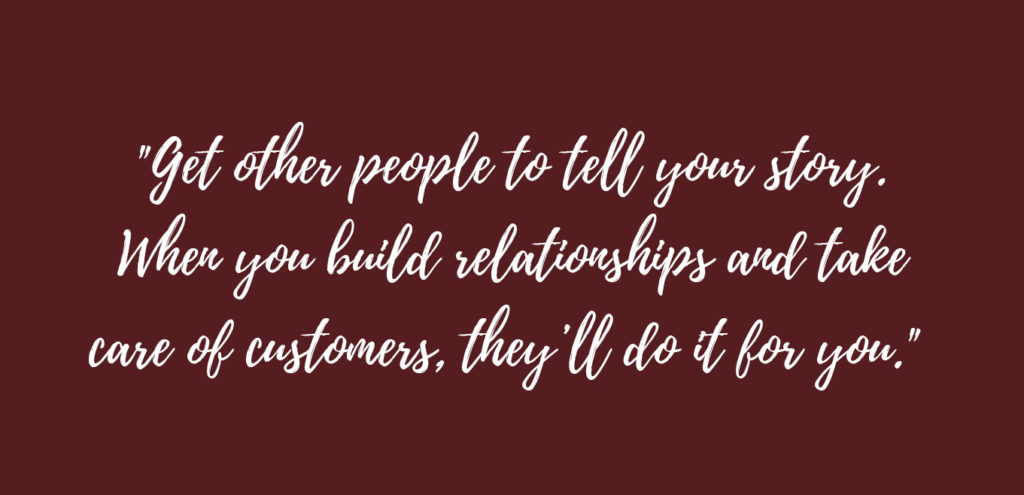From the silver screen to our social media timelines, stories are everywhere. They help us connect, empathize, and even make decisions.
Whether you realize it or not, storytelling is a vital skill for real estate agents. By telling stories properly, you can turn first-time clients into lifelong advocates for your business.
To learn more about the art of storytelling—or, as it’s sometimes called, storyselling—we talked to Sean Carpenter, a veteran agent and in-demand speaker who Inman once listed as one of the Top 100 Most Influential Leaders in Real Estate.
Keep reading to learn how you can use stories to better connect with clients and create a successful business built on relationships.
Find your tribe.

Sean Carpenter has been in the real estate business for more than two decades. His motto is “build relationships, solve problems, and have fun.”
Storytelling has played an important role in helping Carpenter make the personal connections that have buoyed his business. His clients know him not just as their agent but also as the guy who likes to golf, drink craft beer, and crack jokes.
Carpenter attended college in Florida before returning to work in his home state of Ohio. He says this story is one way he differentiates himself from other agents.
“When I put ‘U of F’ (University of Florida) in my bio, that’ll jump off the page for all the people who went there,” he says. “People want to do business with people like them.
“A church member would rather give money to fellow church members, and a fraternity brother would rather work with another fraternity brother.”
In other words, agents stand to gain quite a bit by targeting clients who belong to some of the same organizations, or who share the same interests, passions, and values. The first step is to identify what makes you unique.
“I’d coach an agent to think about their own bio,” Carpenter says. “Once you understand what your bio is, you need to find the people in your tribe, as Seth Godin says.”
He adds, “You don’t want to do business with just anybody—you want to do business with the right people.”
Get your customers invested.

Once an agent has a “tribe” in mind, it’s all about attracting those people to their business. One of the ways Sean Carpenter does this is through social media.
“Instagram Stories are great because you can get people invested in, say, an event,” he says. “Later, they’ll ask you, ‘Did people show up? Did everything go well?’”
Carpenter also uses Facebook to share anecdotes with his followers. He says he’ll sometimes spread them out over multiple posts to get his audience hooked.
Carpenter remembers a particularly popular (and lengthy) two-parter about losing his wallet.
“The number of comments was shocking,” he says. “When I finished the story the next day, all those people tuned back in to find out what happened.”
The story was effective, because it caused his audience to connect emotionally. They became invested.
Help others tell their story.

Vulnerability often plays a big role in Sean Carpenter’s storytelling. He recalls times when he helped widows and widowers, or shared tears with a seller who was saying goodbye to the place they’d called home for years.
He says agents should draw from these experiences when they’re working with people who find themselves in vulnerable situations. Simply letting them know that someone else has been through the same thing can go a long way.
“You could be dealing with someone who was bankrupt or who lost their home in a fire. Maybe there are tears involved,” he says. “Anyone who’s been in the business for at least a year has one of these stories.”
Ultimately, the agent-client relationship is built on trust, which means a willingness to share these emotional stories could be a real difference-maker.
While emotional stories like the examples mentioned above might comfort sellers, Carpenter feels it’s equally important to tell stories to buyers.
“Think about how car dealers tell a story,” he says. “They show a clean car rolling down the Pacific Coast Highway. They know that people don’t want to buy a Jeep to just take their kids back and forth to school.”
The implications for real estate agents are clear: rather than touting the features of a home, agents can appeal to the emotions of a buyer by helping them imagine themselves living there.
Carpenter suggests using specific evocative phrases, such as:
- Entertain in a big kitchen.
- Watch the kids play in this big backyard.
- Walk the dog around the tree-lined neighborhood.
“The house is what they move into,” he says. “The home is what they create.”
In other words, agents should appeal to the buyer’s imagination—to their hopes and dreams for the future. When done effectively, this gets them to connect those hopes and dreams to their future home.
Feel, Felt, Found.

One of the biggest challenges for agents is dealing with uncertainty, whether that’s on the seller’s side or the buyer’s side.
Sean Carpenter suggests using a classic sales technique: The Feel, Felt, Found Method.
- Acknowledge what the other person is feeling.
- Talk about a time when you or someone else felt that way.
- Reveal what you found in that situation.
“Let’s say you’re working with a seller who feels like they could get X amount for a house,” Carpenter says. “You could say, ‘I had another client who thought this, but the house sat on the market for six weeks.’”
From there, the listing agent would suggest what might be a more reasonable asking price, based on their own experience and a comparative market analysis.
In this situation, an agent is appealing to their expertise, but they’re also engaged in emotional storytelling. Carpenter has found this approach more effective than market analysis alone. The key is to subtly use story to add credibility.
“When you and I hear this as salespeople, we know what it is,” says Carpenter. “But when someone doesn’t know that, that’s when it’s more effective.”
Create customer advocates.

Stories can be a great way for agents to convince buyers and sellers who are feeling uncertain. But the power of storytelling doesn’t end with the stories agents tell clients.
For most agents, the goal is to build a business that will grow exponentially through word of mouth—one that thrives on referrals and repeat business, rather than requiring a steady stream of new prospects.
Sean Carpenter is a firm believer in the role stories play in creating that kind of business.
“Get other people to tell your story,” he says. “When you build relationships and take care of customers, they’ll do it for you.”
One way to create customer advocates is by engaging with them around things that have nothing to do with real estate. This could be a sporting event, a shared hobby, or an important event in their lives (e.g., promotion, anniversary, child’s graduation).
The key here is to not only engage, but to add value to the lives of these clients.
“Let’s say I saw you were going on a vacation to Hilton Head, South Carolina,” Carpenter says. “I’d call you and give you the five best places to go to that you won’t see in the guide.”
When Sean does something like this for a client, he’s rising far above what’s expected—acting more like a trusted friend than a real estate agent. And that, he says, is exactly the point.
“Seth Godin’s idea was to turn strangers into friends, friends into customers, and customers into salespeople.”
Of course, stories are incredibly powerful, but they’re only as good as the experience that accompanies them.
“Don’t be part of a bad story by not living up to expectations,” says Carpenter. “We can all go on and on about bad customer experiences, and the bad stories can be embellished more than a good story.”
What’s your story?

Ultimately, if a real estate agent doesn’t shape their own story, their clients will create that story for them—for better or worse.
Sean Carpenter advises agents to think about who they are, as well as how they want customers to see them. This means figuring out what makes them unique and selling that idea to the people they want to work with.
“How is your story going to be different? If it’s just that you sell houses, there are 1.4 million other agents who do that,” he says. “You can be the agent for fellow parents, motorcycle riders, or disc golfers.
“Figure out who your tribe is, then work your way up.”





















